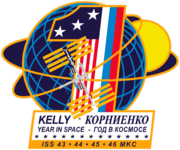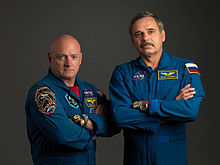ISS year-long mission
| Mission type | Year long duration | |
|---|---|---|
| Mission duration | 340d 8h 43m | |
| Orbits completed | 5,356 [1] | |
| Expedition | ||
| Space station | International Space Station | |
| Began | March 27, 2015, 19:42 UTC | |
| Ended | March 2, 2016, 04:25 UTC | |
| Arrived aboard | Soyuz TMA-16M | |
| Departed aboard | Soyuz TMA-18M | |
| Crew | ||
| Crew size | 2 | |
| Members |
| |

 Scott Kelly and Mikhail Kornienko | ||
The ISS year-long mission was an 11-month-long
On 12 April 2019, NASA reported medical results from the NASA Twins Study which demonstrated several long-lasting changes, including those related to alterations in DNA and cognition, when one twin was compared with the other.[10][11]
Selection
In November 2012,
The goal aboard the orbiting laboratory was to understand better how the human body reacts and adapts to the harsh environment of space.[7] Data from the mission was used to improve assessments of crew performance and health. They worked to develop and validate better countermeasures against the risks associated with future missions around the Moon, asteroids and ultimately Mars.[13]
Results
This section needs expansion. You can help by adding to it. (February 2020) |
On 12 April 2019, NASA reported medical results, from the NASA Twins study, which demonstrated several long-lasting changes, including those related to alterations in DNA and cognition, when one twin was compared with the other.[10][11]
The study also required the astronauts to keep a journal, and investigated the psychological effects of living in a confined space for an extended length of time. Kornienko said of his experiences on Expedition 23/24: "The thing you miss there most of all is the Earth itself, I missed smells. I missed trees, I even dreamt of them. I even hallucinated. I thought I smelled a real fire and something being barbecued on it! I ended up putting pictures of trees on the walls to cheer up. You do miss the Earth there."[14]
Scott stated that he missed feeling changes in the weather while on the ISS.[15]
NASA Twin Study
Effect of spaceflight on the human body
The International Space Station developed exercise equipment, including
Longest time spent in space by other astronauts
Prior to the Year Long Mission, the longest mission on the ISS was 215 days, by
See also
- Scientific research on the International Space Station
- Timeline of longest spaceflights
- Spaceflight records
- Human mission to Mars
References
- ^ Spacefacts
- ^ Jeffrey Kluger (18 Dec 2014). "Meet the Twins Unlocking the Secrets of Space: NASA's One-Year Mission with Mark and Scott Kelly". Time. Retrieved 2015-12-14.
- ^ "Historic yearlong mission crew launches to space station on Soyuz TMA-16M". collectSPACE. 27 March 2015. Retrieved 2015-12-14.
- ^ AFP (27 March 2015). "Soyuz spacecraft with Russian, US astronauts blasts off for year-long mission". Australian Broadcasting Corporation. Retrieved 2015-12-14.
- ^ Brooks Hays (27 March 2015). "Soyuz rocket launches yearlong space station crew". United Press International. Retrieved 2015-12-14.
- ^ Irene Klotz (27 March 2015). "U.S., Russian crew blasts off for year-long stay on space station". Reuters. Retrieved 2015-12-14.
- ^ a b Jason Davis (25 March 2015). "One-Year ISS Mission Preview: 28 Experiments, 4 Expeditions and 2 Crew Members". The Planetary Society. Retrieved 2015-12-14.
- Nasa.gov. 2016-02-24. Retrieved 2016-02-25.
- ^ Gushanas, Timothy (2017-01-30). "First Look at Findings of NASA Twins Study". NASA. Retrieved 2017-02-03.
- ^ a b Zimmer, Carl (12 April 2019). "Scott Kelly Spent a Year in Orbit. His Body Is Not Quite the Same - NASA scientists compared the astronaut to his earthbound twin, Mark. The results hint at what humans will have to endure on long journeys through space". The New York Times. Retrieved 12 April 2019.
- ^ PMID 30975860.
- Eric Berger (20 March 2015). "Year-long mission the next step for Kelly, NASA". Houston Chronicle. Retrieved 2015-12-14.
- ^ "NASA, Roscosmos Assign Veteran Crew to Yearlong Space Station Mission". NASA. 26 November 2012. Retrieved 2012-11-26.
- ^ Chris Arridge (12 September 2015). "Record-breaking astronauts return to Earth – taking us one step closer to Mars". The Conversation. Retrieved 2015-12-14.
- ^ "Crew of First Yearlong Expedition Aboard ISS Previews Mission". YouTube. NASA. 16 January 2015. Retrieved 2015-12-14.
- PMID 30975860.
- New York Times. Retrieved 2009-04-15.
- ^ "Last Human to Spend a Year in Space Discusses Upcoming ISS One Year Mission". YouTube. ReelNASA. 26 March 2015. Retrieved 2015-12-14.
- ^ "Christina Hammock Koch NASA Astronaut". NASA. April 3, 2023.
- ISSN 0190-8286. Retrieved March 30, 2022.
External links
- One-Year Mission - NASA
- NASA - One-Year Mission Investigators Debut Preliminary Results at NASA Workshop (January 30, 2017)
